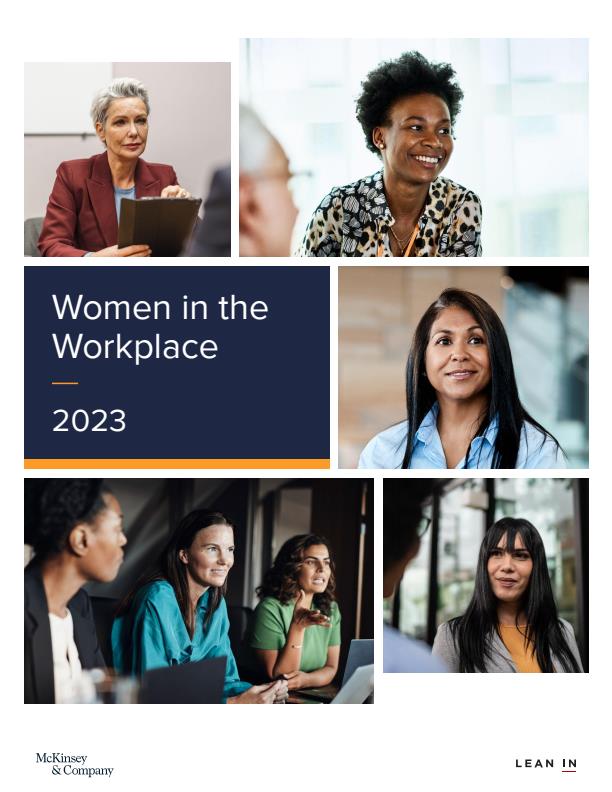This is the ninth year of the Women in the Workplace report. Conducted in partnership with LeanIn.Org, this effort is the largest study of women in corporate America and Canada. This year, we collected information from 276 participating organizations employing more than ten million people. At these organizations, we surveyed more than 27,000 employees and 270 senior HR leaders, who shared insights on their policies and practices. The report provides an intersectional look at the specific biases and barriers faced by Asian, Black, Latina, and LGBTQ+ women and women with disabilities.
This year’s research reveals some hard-fought gains at the top, with women’s representation in the C-suite at the highest it has ever been. However, with lagging progress in the middle of the pipeline—and a persistent underrepresentation of women of color1—true parity remains painfully out of reach.
The survey debunks four myths about women’s workplace experiences and career advancement. A few of these myths cover old ground, but given the notable lack of progress, they warrant repeating. These include women’s career ambitions, the greatest barrier to their ascent to senior leadership, the effect and extent of microaggressions in the workplace, and women’s appetite for flexible work. We hope highlighting these myths will help companies find a path forward that casts aside outdated thinking once and for all and accelerates progress for women.
The rest of this article summarizes the main findings from the Women in the Workplace 2023 report and provides clear solutions that organizations can implement to make meaningful progress toward gender equality.
State of the pipeline
Over the past nine years, women—and especially women of color—have remained underrepresented across the corporate pipeline (Exhibit 1). However, we see a growing bright spot in senior leadership. Since 2015, the number of women in the C-suite has increased from 17 to 28 percent, and the representation of women at the vice president and senior vice president levels has also improved significantly.

These hard-earned gains are encouraging yet fragile: slow progress for women at the manager and director levels—representation has grown only three and four percentage points, respectively—creates a weak middle in the pipeline for employees who represent the vast majority of women in corporate America. And the “Great Breakup” trend we discovered in last year’s survey continues for women at the director level, the group next in line for senior-leadership positions. That is, director-level women are leaving at a higher rate than in past years—and at a notably higher rate than men at the same level. As a result of these two dynamics, there are fewer women in line for top positions.
To view previous reports, please visit the Women in the Workplace archive
Moreover, progress for women of color is lagging behind their peers’ progress. At nearly every step in the pipeline, the representation of women of color falls relative to White women and men of the same race and ethnicity. Until companies address this inequity head-on, women of color will remain severely underrepresented in leadership positions—and mostly absent from the C-suite.
“It’s disheartening to be part of an organization for as many years as I have been and still not see a person like me in senior leadership. Until I see somebody like me in the C-suite, I’m never going to really feel like I belong.”
—Latina, manager, former executive director

Four myths about the state of women at work
This year’s survey reveals the truth about four common myths related to women in the workplace.
Myth: Women are becoming less ambitious
Reality: Women are more ambitious than before the pandemic—and flexibility is fueling that ambition
At every stage of the pipeline, women are as committed to their careers and as interested in being promoted as men. Women and men at the director level—when the C-suite is in closer view—are also equally interested in senior-leadership roles. And young women are especially ambitious. Nine in ten women under the age of 30 want to be promoted to the next level, and three in four aspire to become senior leaders.
Moreover, the pandemic and increased flexibility did not dampen women’s ambitions. Roughly 80 percent of women want to be promoted to the next level, compared with 70 percent in 2019. And the same holds true for men. Women of color are even more ambitious than White women: 88 percent want to be promoted to the next level. Flexibility is allowing women to pursue their ambitions: overall, one in five women say flexibility has helped them stay in their job or avoid reducing their hours. A large number of women who work hybrid or remotely point to feeling less fatigued and burned out as a primary benefit. And a majority of women report having more focused time to get their work done when they work remotely.
The pandemic showed women that a new model of balancing work and life was possible. Now, few want to return to the way things were. Most women are taking more steps to prioritize their personal lives—but at no cost to their ambition. They remain just as committed to their careers and just as interested in advancing as women who aren’t taking more steps. These women are defying the outdated notion that work and life are incompatible, and that one comes at the expense of the other.
Myth: The biggest barrier to women’s advancement is the ‘glass ceiling’
Reality: The ‘broken rung’ is the greatest obstacle women face on the path to senior leadership
For the ninth consecutive year, women face their biggest hurdle at the first critical step up to manager. This year, for every 100 men promoted from entry level to manager, 87 women were promoted (Exhibit 2). And this gap is trending the wrong way for women of color: this year, 73 women of color were promoted to manager for every 100 men, down from 82 women of color last year. As a result of this “broken rung,” women fall behind and can’t catch up.

Progress for early-career Black women remains the furthest behind. After rising in 2020 and 2021 to a high of 96 Black women promoted for every 100 men—likely because of heightened focus across corporate America—Black women’s promotion rates have fallen to 2018 levels, with only 54 Black women promoted for every 100 men this year.
While companies are modestly increasing women’s representation at the top, doing so without addressing the broken rung offers only a temporary stopgap. Because of the gender disparity in early promotions, men end up holding 60 percent of manager-level positions in a typical company, while women occupy 40 percent. Since men significantly outnumber women, there are fewer women to promote to senior managers, and the number of women decreases at every subsequent level.
Myth: Microaggressions have a ‘micro’ impact
Reality: Microaggressions have a large and lasting impact on women
Microaggressions are a form of everyday discrimination that is often rooted in bias. They include comments and actions—even subtle ones that are not overtly harmful—that demean or dismiss someone based on their gender, race, or other aspects of their identity. They signal disrespect, cause acute stress, and can negatively impact women’s careers and health.
Years of data show that women experience microaggressions at a significantly higher rate than men: they are twice as likely to be mistaken for someone junior and hear comments on their emotional state (Exhibit 3). For women with traditionally marginalized identities, these slights happen more often and are even more demeaning. As just one example, Asian and Black women are seven times more likely than White women to be confused with someone of the same race and ethnicity.

As a result, the workplace is a mental minefield for many women, particularly those with traditionally marginalized identities. Women who experience microaggressions are much less likely to feel psychologically safe, which makes it harder to take risks, propose new ideas, or raise concerns. The stakes feel just too high. On top of this, 78 percent of women who face microaggressions self-shield at work, or adjust the way they look or act in an effort to protect themselves. For example, many women code-switch—or tone down what they say or do—to try to blend in and avoid a negative reaction at work. Black women are more than twice as likely as women overall to code-switch. And LGBTQ+ women are 2.5 times as likely to feel pressure to change their appearance to be perceived as more professional. The stress caused by these dynamics cuts deep.
Women who experience microaggressions—and self-shield to deflect them—are three times more likely to think about quitting their jobs and four times more likely to almost always be burned out. By leaving microaggressions unchecked, companies miss out on everything women have to offer and risk losing talented employees.
“It’s like I have to act extra happy so I’m not looked at as bitter because I’m a Black woman. And a disabled Black woman at that. If someone says something offensive to me, I have to think about how to respond in a way that does not make me seem like an angry Black woman.”
—Black woman with a physical disability, entry-level role

Myth: It’s mostly women who want—and benefit from—flexible work
Reality: Men and women see flexibility as a ‘top 3’ employee benefit and critical to their company’s success
Most employees say that opportunities to work remotely and have control over their schedules are top company benefits, second only to healthcare (Exhibit 4). Workplace flexibility even ranks above tried-and-true benefits such as parental leave and childcare.

As workplace flexibility transforms from a nice-to-have for some employees to a crucial benefit for most, women continue to value it more. This is likely because they still carry out a disproportionate amount of childcare and household work. Indeed, 38 percent of mothers with young children say that without workplace flexibility, they would have had to leave their company or reduce their work hours.
But it’s not just women or mothers who benefit: hybrid and remote work are delivering important benefits to most employees. Most women and men point to better work–life balance as a primary benefit of hybrid and remote work, and a majority cite less fatigue and burnout (Exhibit 5). And research shows that good work–life balance and low burnout are key to organizational success. Moreover, 83 percent of employees cite the ability to work more efficiently and productively as a primary benefit of working remotely. However, it’s worth noting companies see this differently: only half of HR leaders say employee productivity is a primary benefit of working remotely.

Employees who work on-site also see tangible benefits. A majority point to an easier time collaborating and a stronger personal connection to coworkers as the biggest benefits of working on-site—two factors central to employee well-being and effectiveness. However, the culture of on-site work may be falling short. While 77 percent of companies believe a strong organizational culture is a key benefit of on-site work, most employees disagree: only 39 percent of men and 34 percent of women who work on-site say a key benefit is feeling more connected to their organization’s culture.
Not to mention that men benefit disproportionately from on-site work: compared with women who work on-site, men are seven to nine percentage points more likely to be “in the know,” receive the mentorship and sponsorships they need, and have their accomplishments noticed and rewarded.
A majority of organizations have started to formalize their return-to-office policies, motivated by the perceived benefits of on-site work (Exhibit 6). As they do so, they will need to work to ensure everyone can equally reap the benefits of on-site work.

Recommendations for companies
As companies work to support and advance women, they should focus on five core areas:
- tracking outcomes for women’s representation
- empowering managers to be effective people leaders
- addressing microaggressions head-on
- unlocking the full potential of flexible work
- fixing the broken rung, once and for all
1. Track outcomes to improve women’s experience and progression
Tracking outcomes is critical to any successful business initiative. Most companies do this consistently when it comes to achieving their financial objectives, but few apply the same rigor to women’s advancement. Here are three steps to get started:
Measure employees’ outcomes and experiences—and use the data to fix trouble spots. Outcomes for drivers of women’s advancement include hiring, promotions, and attrition. Visibility into other metrics—such as participation in career development programs, performance ratings, and employee sentiments—that influence career progression is also important, and data should be collected with appropriate data privacy protections in place. Then, it’s critically important that companies mine their data for insights that will improve women’s experiences and create equal opportunities for advancement. Ultimately, data tracking is only valuable if it leads to organizational change.
Take an intersectional approach to outcome tracking. Tracking metrics by race and gender combined should be table stakes. Yet, even now, fewer than half of companies do this, and far fewer track data by other self-reported identifiers, such as LGBTQ+ identity. Without this level of visibility, the experiences and career progression of women with traditionally marginalized identities can go overlooked.
Share internal goals and metrics with employees. Awareness is a valuable tool for driving change—when employees are able to see opportunities and challenges, they’re more invested in being part of the solution. In addition, transparency with diversity, equity, and inclusion (DEI) goals and metrics can send a powerful signal to employees with traditionally marginalized identities that they are supported within the organization.
2. Support and reward managers as key drivers of organizational change
Managers are on the front lines of employees’ experiences and central to driving organizational change. As companies more deeply invest in the culture of work, managers play an increasingly critical role in fostering DEI, ensuring employee well-being, and navigating the shift to flexible work. These are all important business priorities, but managers do not always get the direction and support they need to deliver on them. Here are three steps to get started:
Clarify managers’ priorities and reward results. Companies need to explicitly communicate to managers what is core to their roles and motivate them to take action. The most effective way to do this is to include responsibilities like career development, DEI, and employee well-being in managers’ job descriptions and performance reviews. Relatively few companies evaluate managers on metrics linked to people management. For example, although 61 percent of companies point to DEI as a top manager capability, only 28 percent of people managers say their company recognizes DEI in performance reviews. This discrepancy may partially explain why not enough employees say their manager treats DEI as a priority.
Equip managers with the skills they need to be successful. To effectively manage the new demands being placed on them, managers need ongoing education. This includes repeated, relevant, and high-quality training and nudges that emphasize specific examples of core concepts, as well as concrete actions that managers can incorporate into their daily practices. Companies should adopt an “often and varied” approach to training and upskilling and create regular opportunities for coaching so that managers can continue to build the awareness and capabilities they need to be effective.
Make sure managers have the time and support to get it right. It requires significant intentionality and follow-through to be a good people and culture leader, and this is particularly true when it comes to fostering DEI. Companies need to make sure their managers have the time and resources to do these aspects of their job well. Additionally, companies should put policies and systems in place to make managers’ jobs easier.
3. Take steps to put an end to microaggressions
Microaggressions are pervasive, harmful to the employees who experience them, and result in missed ideas and lost talent. Companies need to tackle microaggressions head-on. Here are three steps to get started:
Make clear that microaggressions are not acceptable. To raise employee awareness and set the right tone, it’s crucial that senior leaders communicate that microaggressions and disrespectful behavior of any kind are not welcome. Companies can help with this by developing a code of conduct that articulates what supportive and respectful behavior looks like—as well as what’s unacceptable and uncivil behavior.
Teach employees to avoid and challenge microaggressions. Employees often don’t recognize microaggressions, let alone know what to say or do to be helpful. That’s why it’s so important that companies have employees participate in high-quality bias and allyship training and receive periodic refreshers to keep key learnings top of mind.
Create a culture where it’s normal to surface microaggressions. It’s important for companies to foster a culture that encourages employees to speak up when they see microaggressions or other disrespectful behavior. Although these conversations can be difficult, they often lead to valuable learning and growth. Senior leaders can play an important role in modeling that it is safe to surface and discuss these behaviors.
4. Finetune flexible working models
The past few years have seen a transformation in how we work. Flexibility is now the norm in most companies; the next step is unlocking its full potential and bringing out the best of the benefits that different work arrangements have to offer. Here are three steps to get started:
Establish clear expectations and norms around working flexibly. Without this clarity, employees may have very different and conflicting interpretations of what’s expected of them. It starts with redefining the work best done in person, versus remotely, and injecting flexibility into the work model to meet personal demands. As part of this process, companies need to find the right balance between setting organization-wide guidelines and allowing managers to work with their teams to determine an approach that unlocks benefits for men and women equally.
Measure the impact of new initiatives to support flexibility and adjust them as needed. The last thing companies want to do is fly in the dark as they navigate the transition to flexible work. As organizations roll out new working models and programs to support flexibility, they should carefully track what’s working, and what’s not, and adjust their approach accordingly—a test-and-learn mentality and a spirit of co-creation with employees are critical to getting these changes right.
Put safeguards in place to ensure a level playing field across work arrangements. Companies should take steps to ensure that employees aren’t penalized for working flexibly. This includes putting systems in place to make sure that employees are evaluated fairly, such as redesigning performance reviews to focus on results rather than when and where work gets done. Managers should also be equipped to be part of the solution. This requires educating managers on proximity bias. Managers need to ensure their team members get equal recognition for their contributions and equal opportunities to advance regardless of working model.
5. Fix the broken rung for women, with a focus on women of color
Fixing the broken rung is a tangible, achievable goal and will set off a positive chain reaction across the pipeline. After nine years of very little progress, there is no excuse for companies failing to take action. Here are three steps to get started:
Track inputs and outcomes. To uncover inequities in the promotions process, companies need to track who is put up for and who receives promotions—by race and gender combined. Tracking with this intersectional lens enables employers to identify and address the obstacles faced by women of color, and companies can use these data points to identify otherwise invisible gaps and refine their promotion processes.
Work to de-bias performance reviews and promotions. Leaders should put safeguards in place to ensure that evaluation criteria are applied fairly and bias doesn’t creep into decision making. Companies can take these actions:
- Send “bias” reminders before performance evaluations and promotion cycles, explaining how common biases can impact reviewers’ assessments.
- Appoint a “bias monitor” to keep performance evaluations and promotions discussions focused on the core criteria for the job and surface potentially biased decision making.
- Have reviewers explain the rationale behind their performance evaluations and promotion recommendations. When individuals have to justify their decisions, they are less likely to make snap judgments or rely on gut feelings, which are prone to bias.
Invest in career advancement for women of color. Companies should make sure their career development programs address the distinct biases and barriers that women of color experience. Yet only a fraction of companies tailor career program content for women of color. And given that women of color tend to get less career advice and have less access to senior leaders, formal mentorship and sponsorship programs can be particularly impactful. It’s also important that companies track the outcomes of their career development programs with an intersectional lens to ensure they are having the intended impact and not inadvertently perpetuating inequitable outcomes.
Practices of top-performing companies
Companies with strong women’s representation across the pipeline are more likely to have certain practices in place. The following data are based on an analysis of top performers—companies that have a higher representation of women and women of color than their industry peers (Exhibit 7).

This year’s survey brings to light important realities about women’s experience in the workplace today. Women, and particularly women of color, continue to lose the most ground in middle management, and microaggressions have a significant and enduring effect on many women—especially those with traditionally marginalized identities. Even still, women are as ambitious as ever, and flexibility is contributing to this, allowing all workers to be more productive while also achieving more balance in their lives. These insights can provide a backdrop for senior leaders as they plan for the future of their organizations.


